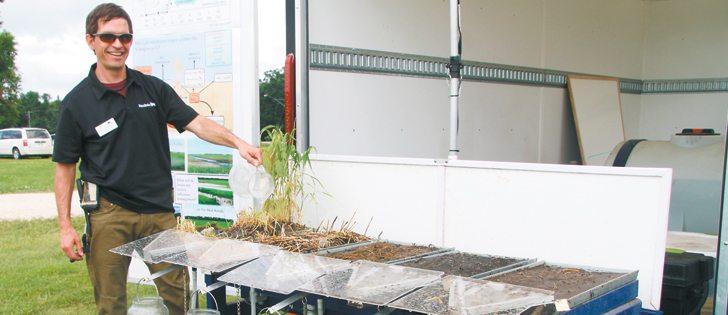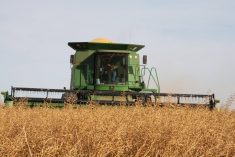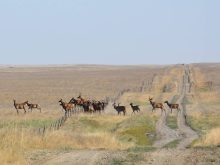CARMAN, Man. — It’s difficult for people to keep walking past Mitch Timmerman’s unique trailer.
The trailer itself is fairly ordinary, something a home renovator might use to haul tools and ladders. However, the apparatus on the back is eye catching.
Five trays of soil are attached to the back of the trailer, and a shower head is mounted above the soil. Ten plastic buckets dangle below the trays, and there’s a control panel to adjust the amount of water falling on the trays.
Read Also

Crop quality looks good this year across Prairies
Crop quality looks real good this year, with the exception of durum.
The peculiar setup looks unusual because there’s nothing like it in Western Canada.
The trailer, partly funded by Fertilizer Canada, was built in the last year. It is known as a water movement learning station, and Manitoba Agriculture will use it to teach farmers, the public and students about water, soil, nutrient loss and crop production.
Timmerman, a Manitoba Agriculture agri-ecosystems specialist, and Clay Sawka, a Manitoba Agriculture nutrient management specialist, displayed the trailer in early July at the Crop Diagnostic School in Carman.
“It’s mostly about water, but we overlay a bunch of other things: soil, fertilizer and so forth,” said Timmerman.
“(We want) to connect the dots between the economic interests of the farmers, the bottom line, agronomics and of course (the) environment.”
Nutrient loss from agricultural land and hog barns became a front page issue in Manitoba about a decade ago when phosphorus flowing into Lake Winnipeg caused massive algal blooms in the province’s largest lake.
It’s also a major concern south of the border, where policy-makers and environmentalists are concerned about runoff from agricultural land and the nutrient contamination in the Gulf of Mexico.
Timmerman said the idea for the trailer came from an agricultural outreach group in Iowa.
“They actually have three trailers like this. They’ve saturated the farmer (audience),” he said. “(Now) they’re mainly taking their trailers to school events, teaching kids about soil, water and agriculture.”
Sawka demonstrated how the unit works by altering the flow of water on the soil trays and tilting the trays to simulate water running across sloped cropland.
The buckets beneath the trays collected water that passed through the soil or ran off the soil surface.
The soils in the trays were different, both in type and how crop residue is managed.
“This one (simulates) a zero till farm,” Sawka said, pointing to a tray with crop stubble. “It (the water) has been (applied) since yesterday … and it’s still holding all the water.”
Timmerman said replicating water and nutrient movement is not a precise simulation of real world conditions.
Instead, it’s a tool to start a conversation with members of the public, including people who may think that farmers are polluters.
“It draws them in. There’s a bit of a wow factor,” he said. “(But) we suggest the audience look critically at the results (of the simulation).”
Timmerman plans to make the rest of the trailer as noticeable as the equipment on the back. It’s now plain white, but he wants to put images of cropland and water on the sides.
















